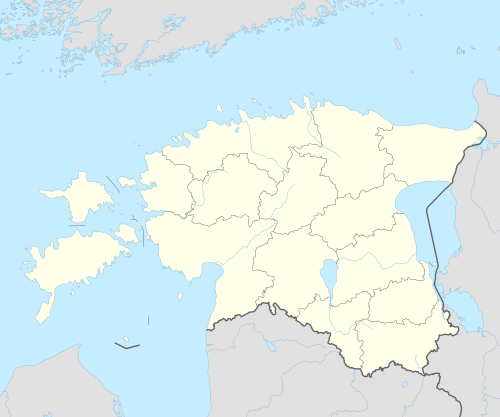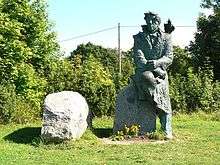Koguva
Koguva is a village on the Estonian island of Muhu. Administratively it belongs to the Muhu Parish, Saare County. Koguva is located on the western top of the island, small Kõinastu islet is located just 2 km (1.2 mi) northwest in the Väinameri Sea. In 2000 Koguva had a population of 30.[1]
Koguva | |
|---|---|
 Typical view in Koguva village. | |
 Koguva Location in Estonia | |
| Coordinates: 58°35′44″N 23°04′50″E | |
| Country | Estonia |
| County | Saare County |
| Municipality | Muhu Parish |
| First mentioned | 1532 |
| Population (01.01.2000[1]) | |
| • Total | 30 |
Koguva was first mentioned in 1532 by Wolter von Plettenberg in document to grant freedom for peasant called Hansken and his son and their descendants. Hansken descendants became called by surname Schmuul later.[1]
Koguva is a small, very peaceful rural village. There are many buildings that are centuries old, dating back to feudal times under Swedish rule, and are still in use today. The northern shore of Muhu, which is claimed to have the clearest water anywhere in the Baltic Sea, is only a short distance away. Koguva offers two bigger countryside places of accommodation right next to each other and some smaller places too.
Writer Juhan Smuul (1922–1971) was born in Koguva and owned his father's farm there until his death. He was a descendant of Hansken but used a simpler surname later in his life. Juhan Smuul's museum was in Koguva from 1970's and has been converted to Muhu Museum in the 1990s.
Gallery
 Tooma farmstead in Muhu Museum.
Tooma farmstead in Muhu Museum. Monument to Juhan Smuul by Matti Varik from 1972.
Monument to Juhan Smuul by Matti Varik from 1972.- Koguva harbour
.jpg) One of three windmills in Koguva.
One of three windmills in Koguva.- Välja farmhouse
 Koguva harbour (aerial view).
Koguva harbour (aerial view).
References
- "Koguva küla" (in Estonian). eestigiid.ee. Retrieved 7 August 2012.
External links
| Wikimedia Commons has media related to Koguva. |
- Koguva village society (in Estonian)
- Koguva Harbour
- Muhu Museum
- 360° Panorama of Koguva
- Pärdi Guesthouse
- Vanatoa Recreational Farm
